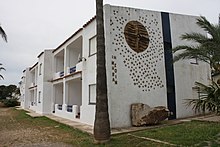
Propane is a three-carbon alkane with the molecular formula C3H8. It is a gas at standard temperature and pressure, but compressible to a transportable liquid. A by-product of natural gas processing and petroleum refining, it is often a constituent of liquefied petroleum gas (LPG), which is commonly used as a fuel in domestic and industrial applications and in low-emissions public transportation; other constituents of LPG may include propylene, butane, butylene, butadiene, and isobutylene. Discovered in 1857 by the French chemist Marcellin Berthelot, it became commercially available in the US by 1911. Propane has lower volumetric energy density than gasoline or coal, but has higher gravimetric energy density than them and burns more cleanly.

Liquefied petroleum gas, also referred to as liquid petroleum gas, is a fuel gas which contains a flammable mixture of hydrocarbon gases, specifically propane, n-butane and isobutane. It can sometimes contain some propylene, butylene, and isobutene.
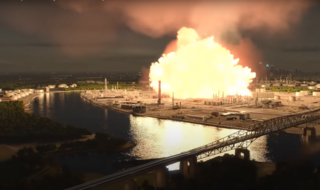
A boiling liquid expanding vapor explosion is an explosion caused by the rupture of a vessel containing a pressurized liquid that is or has reached a temperature sufficiently higher than its boiling point at atmospheric pressure. Because the boiling point of a liquid rises with pressure, the contents of the pressurized vessel can remain a liquid as long as the vessel is intact. If the vessel's integrity is compromised, the loss of pressure drops the boiling point, which can cause the liquid to convert to gas expanding rapidly. BLEVEs are manifestations of explosive boiling.

A tank car or tanker is a type of railroad car or rolling stock designed to transport liquid and gaseous commodities.

A gas explosion is the ignition of a mixture of air and flammable gas, typically from a gas leak. In household accidents, the principal explosive gases are those used for heating or cooking purposes such as natural gas, methane, propane, butane. In industrial explosions, many other gases, like hydrogen, as well as evaporated (gaseous) gasoline or ethanol play an important role. Industrial gas explosions can be prevented with the use of intrinsic safety barriers to prevent ignition, or use of alternative energy.
The Waverly, Tennessee tank car explosion killed 16 people and injured 43 others on February 24, 1978, in Waverly, Tennessee. Following a train derailment a two days earlier, a cleanup crew had been sent into the area. At approximately 2:58 in the afternoon, a tank car containing 30,161 US gallons of liquefied petroleum gas (LPG) exploded after an action taken during the cleanup related to the derailment.
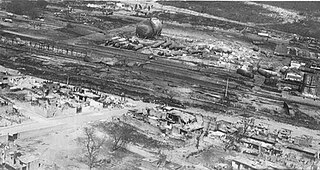
The San Juanico disaster involved a series of fires and explosions at a liquefied petroleum gas (LPG) tank farm in the settlement of San Juan Ixhuatepec, a municipality of Tlalnepantla de Baz, State of Mexico, Mexico, on 19 November 1984. The facility and the settlement, part of Greater Mexico City, were devastated, with 500–600 victims killed, and 5000–7000 suffering severe burns. It is one of the deadliest industrial disasters in world history, and the deadliest industrial accident involving fires and/or explosions from hazardous materials in a process or storage plant since the Oppau explosion in 1921.

Alcanar is a Spanish municipality of the Catalan comarca of Montsià, in the Tarragona province. It is a coastal town on the Mediterranean Sea. The Serra del Montsià range and its foothills rise above the town and its surroundings. According to data from 2006 its population is 9,620 inhabitants, although this increased the next year, to 9,969. It is the southernmost town in Catalonia, located just north of the border with the municipality of Vinaròs which is in the province of Castellón and part of the region of Valencia.
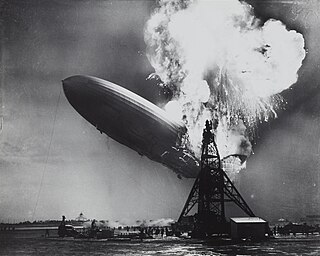
Hydrogen safety covers the safe production, handling and use of hydrogen, particularly hydrogen gas fuel and liquid hydrogen. Hydrogen possesses the NFPA 704's highest rating of four on the flammability scale because it is flammable when mixed even in small amounts with ordinary air. Ignition can occur at a volumetric ratio of hydrogen to air as low as 4% due to the oxygen in the air and the simplicity and chemical properties of the reaction. However, hydrogen has no rating for innate hazard for reactivity or toxicity. The storage and use of hydrogen poses unique challenges due to its ease of leaking as a gaseous fuel, low-energy ignition, wide range of combustible fuel-air mixtures, buoyancy, and its ability to embrittle metals that must be accounted for to ensure safe operation.

The Feyzin disaster occurred in a refinery near the town of Feyzin, 10 kilometres south of Lyon, France, on 4 January 1966. An LPG spill occurred when an operator was draining water from a 1,200m³ pressurised propane tank. The resultant cloud of propane vapour spread, until it was ignited by a car on an adjoining road. The pool of propane in the bund caused the storage tank to be engulfed in flames, which produced a Boiling Liquid Expanding Vapour Explosion (BLEVE) when the tank ruptured. This resulted in a fireball which killed and injured firemen and spectators. Flying missiles broke the legs of an adjacent sphere which later BLEVE'd. Three further spheres toppled due to the collapse of support legs which were not adequately fire protected. These vessels ruptured but did not explode. A number of petrol and crude oil tanks also caught fire. The conflagration took 48 hours to bring under control. This incident resulted in the deaths of 18 people, the injury of 81 and extensive damage to the site.

The Langenweddingen rail disaster near Magdeburg in East Germany caused 94 deaths. It occurred on 6 July 1967 at the village of Langenweddingen, today part of the Sülzetal municipality, on the Magdeburg–Thale railway in the then East Germany when a bilevel train struck a fuel tanker, which exploded as a result of the collision, at a level crossing of Highway 81.
The Kingman explosion, also known as the Doxol disaster or Kingman BLEVE, was a catastrophic boiling liquid expanding vapor explosion (BLEVE) that occurred on July 5, 1973, in Kingman, Arizona, United States.
On 14 January 2020, two explosions at the Chemical Industries of Ethylene Oxide (IQOXE) site in Tarragona, Catalonia, Spain, killed three offsite people and injured seven.

On December 23, 1988, a tractor-trailer tanker truck hauling liquefied propane crashed on an exit ramp at the Interstate 40/Interstate 240 (I-40/I-240) interchange in downtown Memphis, Tennessee, US. The crash ruptured the tank; the leaking gas exploded, setting multiple vehicles and structures on fire. The explosion propelled the tank 125 yards (114 m) into a residential complex and started additional fires. The accident caused nine deaths and ten injuries. The interchange where the accident occurred was considered unsafe and poorly designed, and had been the site of several previous accidents; it was completely rebuilt in the 2000s.
The Chala LPG tanker disaster was a road transport accident that occurred on August 27, 2012, on Indian National Highway 17 at Chala in the Kannur District of India's Kerala State. The accident occurred when an Indian Oil Corporation Limited (IOCL) LPG road tanker hit a road lane divider, overturned and exploded, starting several building fires between 9:30 p.m. and 11 p.m. The accident killed 20 people.
The Boksburg explosion took place on 24 December 2022, when a fuel tanker carrying liquefied petroleum gas (LPG) exploded underneath a railway bridge in Boksburg, in the Ekurhuleni Metropolitan Municipality in Gauteng, South Africa, with a death toll of 41 people as of 18 January 2023. Nearby infrastructure was damaged by the explosion.
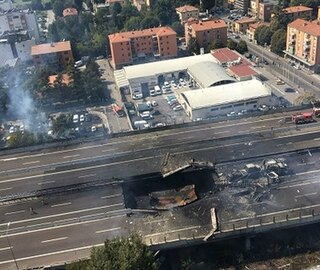
On 6 August 2018, the collision of a liquefied petroleum gas (LPG) road tanker with an articulated lorry carrying flammable solvents and a car transporter resulted in a huge explosion on the A14 motorway within Borgo Panigale, a neighbourhood of Bologna, Italy. It was a case of boiling-liquid expanding-vapour explosion (BLEVE), where nearly all the road tanker cargo combusted in a matter of seconds upon release, generating a tremendous amount of thermal radiation. The accident killed two people, injured 145 and caused significant damage to the surrounding commercial and residential area. One span of the viaduct where it happened collapsed and a gash opened in the motorway.
